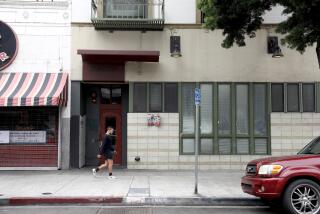$60-Million Loss in 1987 Halted Beverly’s Phenomenal Expansion
- Share via
When Beverly Enterprises took a $60-million loss before taxes last year, it marked an abrupt setback for a company that over the previous decade had grown at a phenomenal rate.
Recurrent allegations of poor patient care have had little apparent impact on the aggressive acquisitions of Beverly’s management team, which bought more than 1,000 facilities in a 12-year period and generated pretax profits that peaked at $103 million in 1985. With 115,430 beds and a work force of 110,460 employees, Beverly is by far the largest nursing home chain in the nation. The next biggest, Hillhaven Corp., is less than half Beverly’s size.
But with Beverly’s losses in 1987, growth was halted, cash dividend payments on company stock were suspended, executive salaries were frozen and officials began selling off some of the company’s homes. Company stock has been trading so low in recent weeks that Beverly is considered a takeover target.
Last month, Standard & Poor’s Corp. downgraded the credit rating of Beverly’s bonds, which will make it more difficult for the company to issue more debt.
Suit Filed
Then, in a class-action lawsuit filed in Los Angeles federal court against Beverly last month, company President David R. Banks was accused of violating securities laws by knowing and failing to disclose to investors “enormous pending wage increases, labor shortages . . . and increased costs.”
Beverly Chairman Robert Van Tuyle called the lawsuit “without merit” and said the company “will vigorously defend against the allegations.”
Despite these reversals, some financial analysts say the company continues to to be a sound, long-term investment, if somewhat risky for the immediate future. They are expecting profits to return by the end of 1988. The entire nursing home industry has been squeezed recently by rising labor costs and lagging government reimbursement rates, but financial analysts point to a “bright spot” ahead. Demographic trends show the elderly to be one of the fastest growing segments of the nation’s population, with one in four people over age 85 now living in nursing homes and more expected to need this care in the future.
Expansion Effort
Investment analysts say Beverly’s problems stem from an expansion effort that put too much emphasis on increasing volume and too little on quality.
“In retrospect, the company absorbed too many marginal or unprofitable facilities, provided inadequate refurbishments and ignored (or was unaware) of minimum-quality standards in many instances,” reported Carl Sherman of Oppenheimer & Co.
Nevertheless, he expects Beverly to soon “regain its prominence and stature in the long-term-care industry.”
Financial analyst Seth H. Shaw at Prudential-Bache Securities said the problems at Beverly are “symptomatic of all the problems facing the industry with one more to boot: sliding occupancy. Even with the supposedly strong demand for nursing home care, Beverly is declining for two reasons: a growing perception of lower quality and the deleterious effects of vigorous competition in California.”
Shaw is more pessimistic than some analysts about Beverly’s prospects and said he could not rule out bankruptcy. But others say that a takeover would be more likely. Last month, there were published reports of an impending takeover bid by the billionaire Pritzker family of Chicago, which controls the Hyatt hotels chain. Spokesmen for both Beverly and Pritzker had no comment.
Leveraged Buyout
Steven Reid of Wedbush Securities criticized Beverly’s top management for spending much of last year trying unsuccessfully to take over the company through a leveraged buyout, instead of focusing on hard times ahead.
“It boils down to a very poorly managed company,” Reid said.
Beverly President Banks acknowledged “We probably grew too fast,” but nobody realized, he said, how much pressure would come from rising labor costs and lagging Medicaid reimbursement rates.
He said he expects a return to profitability this year.
GROWTH OF BEVERLY ENTERPRISES INC. Patients in U.S. 100,000
Facilities in U.S. 1,050
Patients in Calif. 8,770
Facilities in Calif. 86
NATIONAL GROWTH
Total U.S. Revenues Pre-Tax Profits Year Facilities Beds (In Thousands) (In Thousands) 1978 167 19,095 $139,868 $7,814 1979 224 25,021 $173,500 $9,604 1980 328 38,488 $292,745 $15,595 1981 479 51,299 $486,156 $29,575 1982 619 72,711 $805,796 $48,232 1983 783 88,494 $1,091,452 $61,447 1984 908 101,739 $1,420,073 $82,395 1985 1,019 114,507 $1,690,741 $103,130 1986 1,125 122,044 $2,019,262 $90,262 1987 1,052 115,430 $2,093,614 ($60,146)
* Source: Beverly Enterprises Inc. and U.S. Securities & Exchange Commission
More to Read
Inside the business of entertainment
The Wide Shot brings you news, analysis and insights on everything from streaming wars to production — and what it all means for the future.
You may occasionally receive promotional content from the Los Angeles Times.










